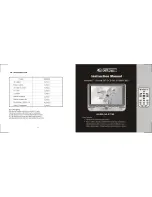
11
External Counter
(TG330 & TG320)
Selecting EXT COUNTER ON sets the COUNT IN socket to external frequency measurement.
The display changes to show a 6-digit frequency measurement and annunciators EXT and 0·5s
show in the display to indicate external measurement and a 0·5s gate time. Alternate presses of
the GATE TIME button beside the display selects between 0·5s and 5s gate time; measurement
resolution is 7-digit with 5s gate time.
In external counter mode the COUNT IN socket has an impedance of 1M
Ω
in parallel with 25pF.
Input frequency range is 5Hz to >20MHz on the 20MHz range and <20MHz to >120MHz (typically
150MHz) on the 120MHz range; range selection is by the 20MHz/120MHz button.
Care should be taken when measuring input signals above 350mV rms (the onset of diode
clipping) with poor signal to noise ratios as under these circumstances it is possible for noise to
generate spurious counts. To ensure a correct count, therefore, noisy signals should be
attenuated externally before being presented to the counter. A convenient attenuation factor of 10
can be achieved by the use of a x10 oscilloscope probe.
Note: With no input signal present the counter will generally self-oscillate when the 120MHz
range is selected and display a non-zero count. This is not
a fault; the frequency reading will be
correct when an adequate input signal is applied.
The function generator continues to perform normally when EXT COUNT is selected.
Calibration and Maintenance
Calibration
The frequency meter is provided with a user recalibration facility which is useful for correcting for
crystal ageing. Since the ageing rate decreases exponentially with time it is an advantage to
recalibrate after the first six months.
Recalibration may be carried out by accessing the trimmer through the hole marked CAL beside
the display using a non-metallic trimmer tool. Adjustments can be monitored by using a frequency
standard or standard frequency receiver to provide a high accuracy signal for the counter set to
external frequency measurement.
Maintenance
The Manufacturers or their agents overseas will provide a repair service for any unit developing a
fault. Where owners wish to undertake their own maintenance work, this should only be done by
skilled personnel in conjunction with the service manual which may be purchased directly from
the Manufacturers or their agents overseas.
Cleaning
If the instrument requires cleaning use a cloth that is only lightly dampened with water or a mild
detergent.
WARNING! TO AVOID ELECTRIC SHOCK, OR DAMAGE TO THE INSTRUMENT, NEVER
ALLOW WATER TO GET INSIDE THE CASE. TO AVOID DAMAGE TO THE CASE NEVER
CLEAN WITH SOLVENTS.













































